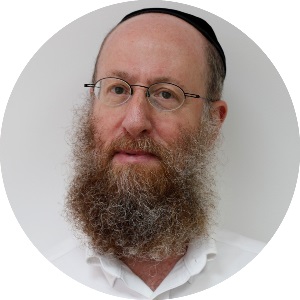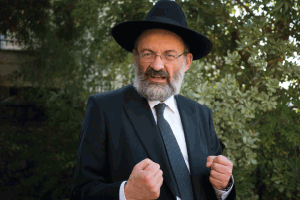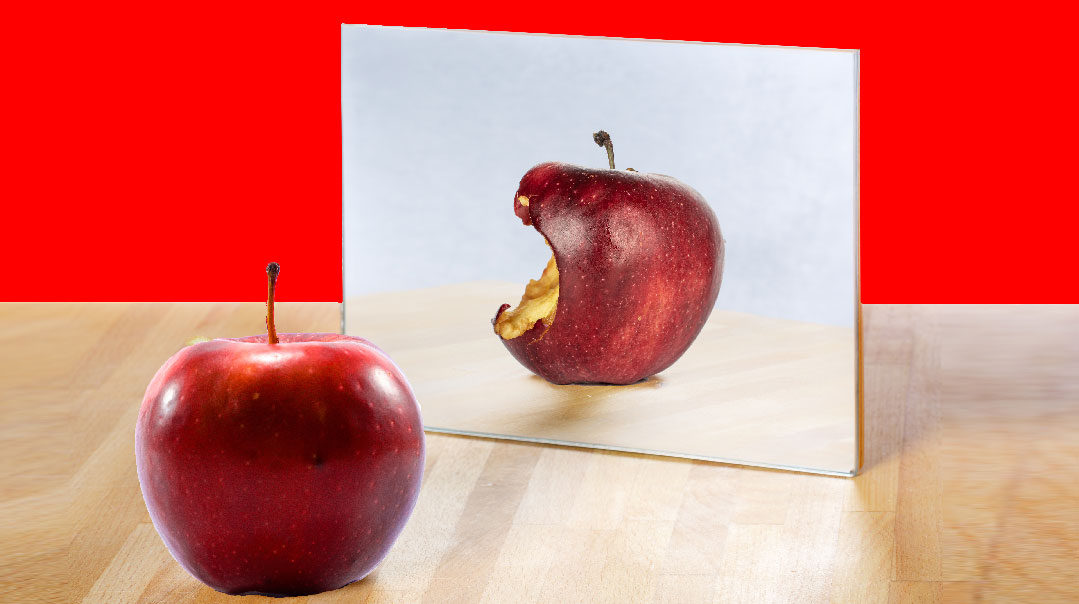The Key to Repentance

Is there a better way to translate our best intentions and sincerest goals into something that lasts? Rav Reuven Leuchter shares a way of conceptualizing teshuvah and applying it to our daily lives

W
hen Rav Shlomo Wolbe was leaving his position as menahel ruchani of Yeshivas Beer Yaakov to move to Jerusalem in 5742 (1981), a yungerman named Reuven Leuchter asked him if he would be willing to continue their rebbi-talmid relationship by chavrusa.
“To my amazement, he said yes,” says Rav Leuchter. For the next 20 years, Rav Leuchter traveled to Rav Wolbe once a week, where among other works, they studied Nefesh HaChaim, the groundbreaking tome of Rav Chaim Volozhin.
“I have no notes or recordings from those sessions,” said Rav Leuchter last week, as he sat in a modest storeroom that serves as his office in Jerusalem’s Sanhedria Murchevet neighborhood. “He forced me to concentrate and educated me to listen. Many times, I would daven to Hashem for help because my head was pounding, but Rav Wolbe was ‘merciless.’ He kept pushing things and I had to put them in my head. He also had a great memory. He would tell the same joke with the same words months later and he would check to see if I was making a face like ‘I heard that already.’ ”
What was the Rav’s point?
“If you make that face, then you’re not listening. If you’re listening to Beethoven, do you say you know the symphony already? If you do, then you’re not listening. Listening means that even when you’re hearing the same story, you might pick up a minute detail you never understood before.”
Thanks to his tireless effort and dedication, Rav Leuchter became one of Rav Wolbe’s most prominent disciples and is considered a leading baal mussar of this generation. He runs numerous mussar vaadim in Israel, trains young rabbanim for careers in outreach with Ner LeElef, and has just finished his new sefer — Teshuva: Restoring Life — just in time for teshuvah season. Originally written in Hebrew, it was adapted into English by Rabbi Gideon Pogrund.
Another common bond between the Swiss-born Rav Leuchter and his rav and mentor — a bond that has a bearing on his work — was the German language. Rabbi Leuchter assisted Rav Wolbe in translating one of his seforim into German, and watched as Rav Wolbe struggled for two weeks on how to translate the words v’yisangu mituvecha.
“Normally you would translate that as ‘they delight in Your goodness.’ ” The Mashgiach wasn’t happy with that phrase, but he couldn’t find a word or phrase in use today that conveyed its true essence.
Finally it came to him. The words oneg, nega, and nogei’a are all derived from the same root, to be “touched.”
“It means internally touched, or moved, or to have a feeling of being stirred, like a mother who gazes intently at her child with delight,” said Rav Leuchter.
The words v’yisangu mituvecha come from the Shabbos prayers, but whether the subject is the weekly Shabbos observance, our daily avodas Hashem, or even the seasonal teshuvah period, the same overriding concept must prevail, says Rabbi Leuchter. Somehow we must feel touched at the very roots of our souls to feel a deep connection to our Creator and desire to make His Will into our will.
It’s a lofty concept, but what does it really mean? How does it apply to our hectic, stressed-out lives? And what is it about this annual struggle that we find so insurmountable, sometimes even depressing?
As Rav Leuchter writes in his introduction:
A great spiritual awakening takes place each year. During the month of Elul and in particular during the period between Rosh Hashanah and Yom Kippur, the clarion call to teshuvah (repentance) rings out. Roused by this call, many of us earnestly seek guidance, searching for ways in which we can work on ourselves and become closer to Hashem. Classic mussar (ethics) books, which might have remained closed throughout the year, are studied. Special shiurim (classes) devoted to personal development and growth attract large crowds.
But as powerful and widespread as this awakening may be, what are its long-term effects? Isn’t there frequently a rapid dissipation of the desire to change? Ultimately, are our sincere intentions and heartfelt aspirations to do teshuvah expressed in a concrete and lasting way? And when this personal transformation does not materialize in the wake of Yom Kippur, is there not a progressive weakening of our resolve? Do we not experience a sense of impotence which grows from one year to the next?
“People embark on the path of teshuvah, not only because they have an emotional desire to do teshuvah, but because they have made a rational decision to do so,” Rav Leuchter explains. “But the general experience is that most people fail to make lasting change, and then they’re caught in a loop. When next year arrives, they make the same decision again, determined to be stronger, but it still doesn’t work. You can go for 70 years like that. How long would General Motors build a car that doesn’t move? After one or two failures, they would immediately say we have to change something in the structure. But to my amazement people don’t do this with teshuvah.
“So I tried to find a new structure for doing teshuvah that will result in real change. The main ideas behind my approach are in the Nefesh HaChaim. Normally, you don’t learn Nefesh HaChaim as a hadrachah sefer, but my chiddush here is that it works together with Rav Yisrael Salanter’s mussar approach of making small changes. The structure is based in our mesorah, so it is ‘believable’ but still practical for our times. You can’t do teshuvah the way we did it 100 years ago.”
Why not?
“A hundred years ago, ruchniyus was tangible. In our day, ruchniyus is something distant and imperceptible. How long did Rav Chaim Volozhin spend with the Vilna Gaon? Maybe two weeks a year? Could you thrive an entire year off of two weeks? Rav Chatzkel Levenstein once heard a shiur on emunah from Rav Yerucham and left saying, ‘I have no emunah’ — so he worked the rest of his life on his emunah.
“Now comes a very tricky point in the teshuvah business. In the end, teshuvah is an inner change. It’s not only an action. The Mesillas Yesharim says akiras haratzon [uprooting our will] has the same effect as uprooting your actions. But that’s a very lofty aim. How do you uproot your will when you often have two opposite wills in your heart? Yes, you may nurture a new ratzon to do better, but the old one is there, and chances are the old one is still much stronger. So what do we do now? That, I think, is the background of the whole sefer.”
Would it be more accurate to classify this as an exchange of will, rather than a change of will?
“The point of teshuvah does not mean that you are a better person. Teshuvah doesn’t mean self-development. It means — in a most literal sense — returning to what Hashem wants from us. It’s a return to Torah and mitzvos. A misguided will causes you to feel alienated from Torah and mitzvos, so that you’re not davening or learning well, or not doing mitzvos bein adam l’chaveiro well. Let’s say that I myself don’t put enough emphasis on learning Torah. Yes, I speak with people, I help people, I help my wife and children, but that distances me from learning Torah. I know the Borei Olam demands that I learn Torah and I have to relate to His demand. If I don’t do it well, why is that? Is it laziness, or because I’m spending too much time trying to please my children or other people, or I’m assigning a greater value to other things?
“To do teshuvah in the truest sense of the word, I can’t just change my actions. I must acknowledge that the Borei Olam’s demand of limud Torah is not only demanded from me, but that it is agreeable and satisfying to me. It fits into my life.
“This is our biggest challenge. If you just say I’ll do what Hashem wants from me, you may decide to do it, but you won’t actually do it. You first have to develop a new self-concept. Do we ever really ask ourselves, What does the Borei want from me? What He truly wants is that we connect to and remain connected to Torah concepts. Learning doesn’t only mean sitting in front of a shtender. Learning can also be thinking about a pasuk, or a Torah concept. Now that begins to sound interesting. That sounds like something doable. In the morning, I will learn a half-page or a page of a sefer that interests me, and I will chew it over during the day, wherever I am. That way, I work it into me, in a way that fits my life. Hashem’s demand becomes my will — not just something I’m expected to do, but one that suits me.
“The alternative is a noncreative process, where your concept of avodas Hashem is succumbing to something that has to be done. What you have to do is craft a creative process that aligns the demand that I learn with my own desires, and only then does it become real.”
How does such a process bring someone closer to real teshuvah?
“What you try to do is to take the kabbalah you intend to make on Yom Kippur, and make it real — even while still in Elul. You might say, ‘I will get up at 5:30 in the morning and learn something extra,’ and find you keep it with you and it actually works. Or you might try it out, and modify or fiddle with it, but the idea is for you to stand there on Yom Kippur and envision a new reality, one that is agreeable to you, and say this is my new reality. Once you have passed through such a process, you can begin to feel a sense of real shame. Not over the fact that you did not fulfill our duties, but because you have a neshamah that’s rooted in the Heavens, and until now, did not begin to utilize it to reach our own potential. When we reach a level where we feel this type of shame, then we can say we have become a chozer b’teshuvah. That type of shame sticks with you and you start to live your life differently.”
How many kabbalos can one conceivably make at one time so that they stick?
“You have to choose your kabbalos carefully. Let’s say I decide I’ll put negel vasser next to my bed and cover it too. Gevaldig. You know what the Borei Olam will tell me? Leuchter, you’re a rotzei’ach! What you should be doing is giving the people you counsel your full attention, and not fiddle with e-mail on the computer when you’re talking to people. I know a person who was very corrupt in his middos, and yet his kabbalah was to put on his hat when he says asher yatzar!
“You have to look for areas that are weighty in the Eyes of Hashem, not yours. Negel vasser is important, but it’s not vital to the same degree as lashon hara, for example. If you decide that it would be good to stop speaking lashon hara, then as I wrote in the sefer, one approach might be to insist that the members of one’s family make a determined effort to at least refrain from speaking lashon hara about each other. This will change the atmosphere in the home into one infused with positivity, purity, and tranquility.
“Regarding your specific question, the number of kabbalos is not important. When you change an aspect of your life in something that’s weighty in the Eyes of the Borei Olam, your will to make that change will not fade away. This is because you’re not just adding an item to your to-do list — instead, you’re exchanging one reality for another reality and not just doing something that you think is demanded, or wanted of you.”
“This is one of the deepest concepts in the sefer. I learned this from Rav Wolbe and it sounded to me like he received it from his rebbeim. Let’s say I love spicy food and you like sweets. Is that something we can argue over? That would make no sense, because that’s what I enjoy and that’s what you enjoy. Enjoyment is taanug, and taanug, like ne’imus, is a factor very much rooted in my personality. The roots of my personality determine what sits well with me.”
“Now, a taanug is not a taavah. A taavah means something that grabs me by the neck and tugs at me. A taanug is contemplative and calm, and suited to me. Oneg is from the root nogei’a. When we say l’hisaneig b’Hashem, it means you’re touched by Hashem, so taanug or ne’imus means you are touched inside. Amira ne’ima means you want a connection with the Borei Olam and that what he tells you to do is touching you positively. So my task is to align a command of the Borei Olam with a new action of mine that then becomes important to me, and enables me to connect with Him personally. That is the stage of teshuvah known as kabbalas l’haba, accepting the new behavior upon yourself, and is one of the main parameters of teshuvah.”
How does one choose the correct action for him/herself that is both important to the person and allows the person to get aligned with Hashem?
“This is creative work and requires conceptualization. Many people have a problem with davening. This doesn’t mean they don’t have time to daven — it means it doesn’t speak to them. If that’s the case, maybe they need to change their concept of davening. Or people feel they aren’t touched by their tefillin. It’s a mitzvah they do, but they’re not connected to it.
“Did you ever see someone with a tattoo of the yud-kei, vav-kei? Do you know that when you put on your tefillin every day, you are writing the name of Hashem on your body? There can’t be a chatzitzah, it has to be on your body. We are not creative with the concept, because we think it’s a duty and it doesn’t speak to us, but when you make tefillin into a concept, then it becomes ki Sheim Hashem nikra alecha [the Name of G-d is ‘called’ upon you]. This speaks to me. Even if you have this thought for five minutes of the time that you wear tefillin, it speaks to you, and you have a kabbalah in kedushah and you’re a heiliger mentsh [holy person] for five minutes.”
T
eshuvah, then, is not merely about changing our actions. It is about changing the character traits. It is about will and drives that lead us to leave the world of Torah. It is about building a refined human being. We often define avodas Hashem as the extent to which we fulfill mitzvos and avoid aveiros. This does, indeed, define avodas hamitzvos, but it does not define avodas hateshuvah. The work of teshuvah is altogether different — its purpose is to transform our character traits so that they become aligned with the will of Hashem. We are, of course, obligated to fulfill all of the mitzvos and to refrain from all of the aveiros enumerated by the Torah. We need to seek out and employ different strategies to ensure that we act in accordance with these obligations. With the aid of clever tactics we try to defeat our yetzer hara and encourage our yetzer hatov, thereby improving our behavior according to the requirements of the Torah. This is crucial work, but it has little to do with teshuvah. The work of teshuvah is carried out on a much deeper level — it is not about using tactics to change our actions. It is rather about working on ourselves to the point where our drives and desires, and indeed all of our being, are in line with the world of Torah.
The Nefesh HaChaim explains how we can concentrate our efforts on a higher level, thus offering an extraordinary insight into how we can approach teshuvah (Shaar 1, Chap. 18): even if Jewish souls are steeped in evil desires, Hashem has established that these souls should be raised up by means of His ruach, in accordance with the verse “I (Anochi) am Hashem your G-d, Who took you out of the land of Egypt.”… This is expounded by Chazal (Shabbos 105a): Anochi is an acronym for… Amira ne’ima kesiva yehiva (A pleasant statement was written and given). These correspond to two aspects of the soul — nefesh and ruach.
The word amira suggests that Anochi relates to speech, which corresponds to ruach, the second level of the soul — and this is associated with talmud Torah. The word ne’ima means sweet or pleasant, implying that the experience of receiving Torah deeply touches us. Torah study allows us to access a higher level of the soul (as ruach is above nefesh), and it is from here that we can be affected.
Our approach may seem to contradict the Sefer Hachinuch’s famous statement about personal change and growth: “The heart is drawn after the actions.” According to the simple understanding of this statement, the performance of any positive action will necessarily and inevitably result in the creation of a positive inner will, which is likely to lead to more positive action. This implies a classic “outside-inside” approach, by sharp contrast with the “inside-outside” approach outlined in this book. However, a closer examination of the context in which this statement appears will reveal that the Sefer Hachinuch’s approach is much more nuanced.
Actions cannot generate a positive will that does not yet exist. They can only strengthen and intensify an existing will — a will which already is in place. For example, when we educate our daughters in the ways of tzniyus by focusing exclusively on the importance of wearing their school uniform, we may well encourage a sense of social belonging, but we are unlikely to instill in them a sense of genuine modesty. This is because women and girls tend to already identify with a particular community, and thus when they dress in a similar fashion that identification is bolstered. Their pre-existing feeling of belonging is reinforced by their dress code. This may indeed be a good thing, and to the outside observer it would appear also to be a clear demonstration of tzniyus. In reality, however, by placing the educational emphasis entirely on our daughters’ actions, meaning on the issue of what type of clothing is acceptable, we will not influence their values, thoughts and feelings. To some extent, those must first be cultivated. It would be better for us to teach the importance of holding back, of not exposing the full measure of what we possess — whether it be physical beauty, knowledge or wealth. This inner quality of modesty will then be strengthened and intensified by the modest dress code.
What about a woman’s teshuvah process?
Unlike men, women are not required to engage in Talmudic study. They are certainly obligated to study practical halachos relevant to them and to understand how one should conduct herself. However, women are not expected to involve themselves in the intricate discussions and debates which underpin the halachos. While the study of practical halachah is essential in order to know what to do, it cannot by itself lead to the inner change which is so vital to teshuvah. We would therefore like to suggest an approach to teshuvah for women which is different, but no less meaningful. It is based on the unique role and contribution of women in the area of interpersonal relationships. More often than men, women seem to have a natural and profound understanding of the psychological and emotional dynamics between people, as well as an extraordinary sensitivity to the nuances that are part of personal interaction. Simply put, women tend to be more sophisticated and intelligent than men in this regard. Middos (character traits) are the main influence on our relationships. They shape both our perceptions and our reactions. How we think, how we feel and what we do is, to a large extent, a product of our middos. On account of the close affinity that women often have with the sphere of middos, character refinement and interpersonal relationship, it appears that women will have a unique opportunity to find depth and growth in the field of tikkun hamiddos. In a more profound sense, middos are a vital key in all areas of our avodah — and working on middos is a far broader enterprise than the specific disposition involved.
(Originally featured in Mishpacha Issue 529)
Oops! We could not locate your form.













